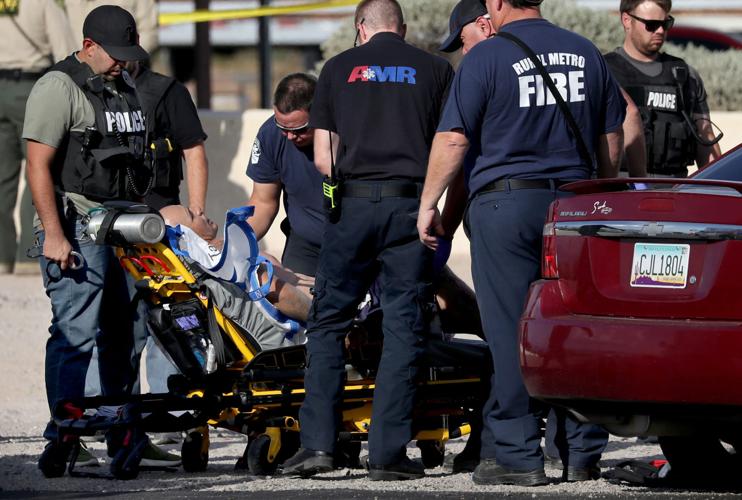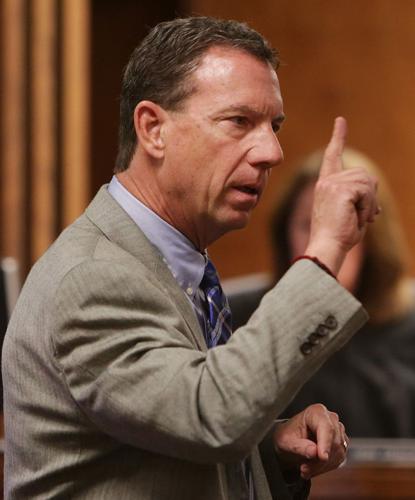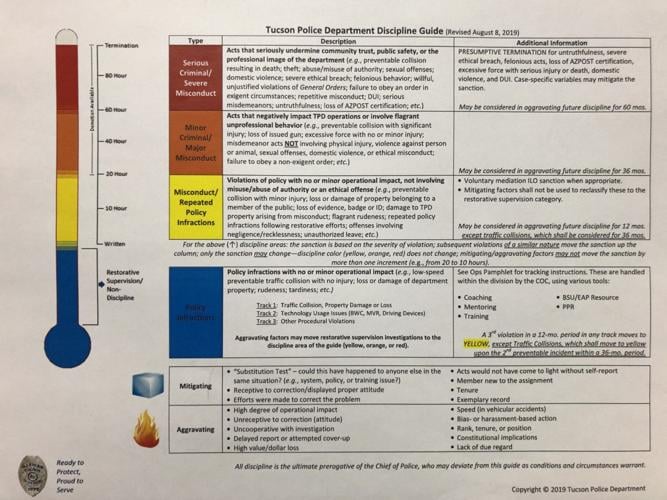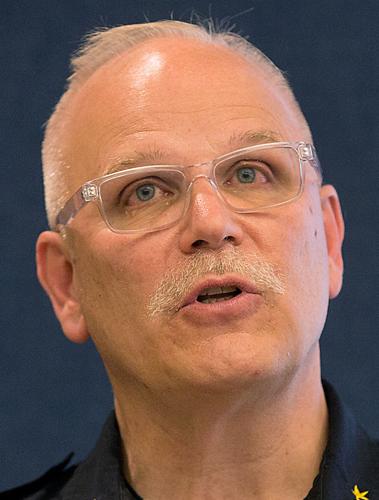A Tucson police officer who fired several rounds into an immobile car at the end of a chase that had its windows tinted so dark he was unable to clearly see the driver he was shooting at — or any others who might have been in the vehicle — is back on the force after a city commission decided losing his job was too harsh a punishment.
Chief Chris Magnus says the termination reversal of Officer Alfred Anaya is the latest ruling by the city’s Civil Service Commission that’s thwarting his efforts to rid the department of problem cops. A top defense lawyer here, however, counters that the decisions of the commission required by the city’s Charter to review the department’s discipline against its officers is simply allowing due process to run its course
The five-member commission created by the city charter has members appointed by the mayor and council to six-year terms. Members must be appointed based on their political party (two Republicans, two Democrats and one person from an alternate party.) Currently, there are only four members.
The CSC’s primary duty is to hear appeals of discipline by city employees, not just police officers, and decide if the punishment fits an infraction.

Tucson police chief
The Civil Service Rules and Tucson City Code’s definition of just cause includes a list of actions that will lead to discipline up to and including termination. The list of fireable infractions in the city includes items such as dishonesty, violation of department rules and regulations, and conduct that would cause “the city or the department to question an employee’s reliability, judgment and trustworthiness in carrying out assigned responsibilities.”
While the commission can’t direct or create department or city policy, TPD officials say that in recent years its disciplinary decisions are often reversed if the commissioners are moved by an employee’s story.
“The CSC is important and these people have good intentions,” Magnus said. “But there’s a long history of this and they’re going further astray of what they were charged to do.”
Magnus said he believes the commission’s recent decision involving Officer Anaya resulted in the department being forced to reinstate an officer who used excessive and deadly force is not in line with public sentiment here, particularly after the unrest that occurred over the summer following the death of two men while in custody in separate incidents.
“I am going to kill you”
In the case of Officer Anaya, he was fired in July after TPD said he violated five policies, including department rules over the use of deadly force.
On July 16, 2019, officers conducing surveillance on a “known gang target house” began following a car that they saw leave, according to the minutes from Anaya’s appeal hearing. Officers believed the driver’s actions were “consistent with narcotic sales activity,” and followed the car for about 10 minutes, until Anaya saw the driver commit a traffic violation, the minutes said.
When the car pulled into the parking lot of a fast-food restaurant on South Palo Verde Road, Officer Jesus Tapia initiated a traffic stop in his marked patrol vehicle, according to the 771-page OPS investigative report. Later, the driver, 37-year-old Vincent Linarez, put the key into the ignition and tried to close the car door. Tapia pulled out his gun, used it to “jab” Linarez on the left side of the head several times while saying, “I am going to kill you, (expletive,)” the OPS report said.

Vincent Linarez
A second officer reached into the car and tried to pull out Linarez, who put the car into drive and drove forward. Tapia jumped out of the way and the other officer fell to the ground. Anaya began to run toward Linarez’s car as it sped toward two unmarked police cars and maneuvered around them, the report said.
Body camera footage showed Anaya yelling, “Shoot him! Shoot him!” and “Ram him! He tried to run us over!” as he ran toward the car.
The three officers chased Linarez’s car toward Palo Verde Road, where it crashed into a white van. Anaya and Tapia ran toward the car, with Anaya yelling at Linarez to “Get on the ground, (expletive)” when another unmarked police car drove into the front passenger wheel well of Linarez’s car, disabling it, the OPS report said.
Two seconds after Anaya yelled at Linarez to get on the ground and immediately after the second crash, Anaya fired his gun six times into Linarez’s car. Five of those rounds hit the driver’s side door and one hit the ground, according to the OPS report.
Anaya was the only officer on scene who fired his gun.
The following video contains graphic content and profanity:
Body camera footage from a July 16, 2019 traffic stop that led to a shooting by police on Tucson's south side.
Linarez, who was shot twice in the lower body, was pulled out of the car by Tapia, who yelled at him to put his hands up, saying, “I’m going to (expletive) kill you!” Body camera footage shows Tapia hit Linarez in the head three times with his gun as he yelled, “We (expletive) told you! Didn’t we (expletive) tell you?”
Linarez is facing several felonies in connection with the incident, including unlawful flight from law enforcement, aggravated assault with physical injury, aggravated assault with a deadly weapon and endangerment, according to Pima County Superior Court records. At the time of the shooting, Linarez had an active warrant for failure to appear in court on a weapons misconduct charge.
Tapia, who was found to have violated four department policies, including cruel, unlawful or improper treatment and use of force for retaliation or punishment, resigned in lieu of termination.
During his interviews with police internal investigators, Anaya said that he didn’t believe Linarez posed a lethal threat after the car was immobilized following the second crash, but that Linarez became a lethal threat when he began moving inside the vehicle.
“So I pull my gun out as he’s moving around and uh, shoot toward the driver door where his, like, center mass of his body would be to stop him from moving anymore,” Anaya told investigators. Anaya also said during the surveillance and subsequent shooting, he had no idea if the backseat of Linarez’s car was occupied.
Several other officers at the scene told a TPD investigator they opted against firing their guns because they weren’t able to see inside the vehicle and did not identify a deadly threat.
During the multilayered executive review of Anaya’s termination, only one superior officer, then-Captain Justin Lane, did not agree with the internal findings that Anaya improperly used deadly force.
TPD’s general orders say that use of deadly force must be objectively reasonable and “based on the totality of circumstances known by the officer at the time force was used.” Anaya told OPS investigators that to some degree, his decision to use deadly force was based on all factors that occurred during the incident, even some that occurred before they made contact with Linarez.
At the time that Anaya fired upon the car, Linarez was “a silhouetted individual in a nonmoving damaged vehicle,” which Assistant Chief Kevin Hall said in his review is not something that an objectively reasonable officer would have considered to be an imminent threat.
Lane disagreed, saying in his review that he believed Anaya’s use of force was justified and within policy and said that the suspect determined the outcome of the incident, not officers.
“Unlike the investigative methodology utilized by OPS, my examination into Officer Anaya’s decision to use deadly force in this instance is based on all of the circumstances, from start to finish, that considered collectively established Mr. Linarez as a threat at the time Officer Anaya shot him,” Lane wrote in a May 10, 2020 memo outlining his reasons for disagreeing with Anaya’s termination.
Lane’s “broad analysis” perspective sets a dangerous precedent, Hall wrote in his executive review, saying that it “allows an expansive layer of subjective rationalization” that can provide justification to use deadly force in an “alarmingly wide” set of circumstances.
“The content of his testimony is a problem for the department,” said Magnus, who added that the city cannot discipline employees based on the content of their testimony in these situations, as it can appear retaliatory. The department is consulting with the city attorney about how to handle the situation and make sure that the use of force policy as it’s written is followed by every member of TPD.
Magnus said he doesn’t believe Lane’s testimony was the linchpin that made up the CSC’s minds, but that Lane’s beliefs about the policy are problematic. On Aug. 16, Lane was reassigned to lieutenant. TPD would not comment on the reason for the change, only saying all captains are actually lieutenants who are assigned to the rank of captain.
“A very dangerous person”
After a nearly two-hour executive session on the final day of Anaya’s hearing, the commission engaged in 21 minutes of public deliberations before rendering its decision.
Chairman Thomas Palomares, a local financial adviser, said that he paid particular attention to four areas of TPD’s general orders in rendering his decision: Objective reasonability, proportionality, provocation and deadly force.
Palomares said that when Anaya fired his gun at Linarez’s silhouette, that might not have been the most “optimal time” to fire, but that he believed Anaya did so because he felt the situation was escalating and needed to take action.
“I do believe it was objectively reasonable what he did. I believe his actions likely prevented further harm to other officers and the public at large,” Palomares said, adding that he didn’t believe Anaya’s actions or misconduct were so severe to cause TPD to no longer trust him.
Commission member Becky Montaño said that Anaya knew Linarez was “a very dangerous person,” because TPD was already tracking the gang with which he was suspected to be involved. Montaño also said that the disagreement between Lane and OPS investigators and the other chiefs showed inconsistency.
Commission member Carol West said she believed Anaya’s decision making was based on the danger he believed Linarez posed to other officers and the public.
“Emotions were running very high and it’s difficult for me to believe that city met the burden of proof that Anaya acted out of policy,” West said, adding that Linarez had a car and had already committed aggravated assault, indicating that he was an imminent threat.
After the commission’s decision, Magnus issued a statement saying that he believed their decision undermined his responsibilities and decisions to hold officers accountable for policy compliance.
“While the Commission has reinstated this officer, he will not be returning to patrol,” Magnus said at the time.
As of Tuesday, Anaya was working at the front desk of one of TPD’s substations in a role that keeps him off street patrol, said Assistant Chief Mike Silva.
“His face terrified me”
In April, the Tucson police union filed a grievance against Magnus regarding four officers that had been reassigned to desk duty following disciplinary actions that landed them on a list of officers whose behavior could cause their testimony in court to be called into question. At the time, Magnus said that officers who are dishonest or commit crimes pose an “unacceptable risk” to the community when it comes to handling complaints or investigations.
In October, the commission overturned the termination of Officer Nicholas Horn, a four-year department veteran, after a domestic violence arrest involving his live-in girlfriend, a fellow TPD officer. In January, AZPOST reviewed Horn’s case and closed the case without action. Still, Magnus has said he’s not comfortable putting Horn back out on the street.
“Victims shouldn’t have to deal with someone who has committed domestic violence,” Magnus said, adding that Horn and other officers who have been fired for domestic violence-related arrests and later reinstated by the city commission have to be assigned somewhere other than patrol. Tucson police officers and Pima County sheriff’s deputies respond to about 15,000 domestic violence-related calls each year, which account for a large portion of incidents officers handle.
There are five TPD officers relegated to desk duty as a result of disciplinary issues, according to the department. One of the four from last year’s grievance lost his peace officer certification and was fired as a result. He did not appeal his second termination.
Their nondeployable officers’ jobs range from manning the front desks at substations to assisting at the Pima County jail.
On March 28, 2019, Horn and his girlfriend got into an argument in their home, during which Horn punched a hole in the wall of the guest room, looked at his girlfriend and said, “You’re next,” according to the CSC documents from Horn’s appeal. At the time that he punched the wall, Horn was standing about 5 feet away from his girlfriend, who told investigators that she felt threatened by the comment, adding, “his face terrified me.”
TPD opened a criminal investigation into the incident, and several weeks later, Horn was charged with domestic violence-related disorderly conduct, criminal damage and threatening and intimidating, all misdemeanors. TPD also opened an administrative investigation into Horn’s behavior and found that he violated several department policies. The infraction made termination the presumptive punishment.
At the end of Horn’s two-day hearing, the commission deemed firing too harsh a punishment for Horn. The commission instead ordered Horn be suspended for six months without back pay.
It ended in April and Horn was assigned to help process inmates at the Pima County jail.
“Shouldn’t have to force you to do the right thing”
The commission’s decisions in Anaya’s and Horn’s cases represented due process, says Mike Storie, the Tucson defense attorney who represented Horn and Anaya and head legal counsel for the Combined Law Enforcement Associations of Arizona.
Storie added that Magnus’ claim that keeping officers on the force who have violated department policies goes against public sentiment “presumes that these officers did actually commit some type of misconduct.”
“In Anaya’s case, three objective people sat through three full days of testimony and determined that his use of force was within policy,” Storie told the Star. “The baseline determination for the commission is, was there a policy violation? They said there was none. That’s why they gave him no discipline and full back pay.”
For officers like Anaya and Horn, who have been reassigned following CSC decisions, there’s essentially no recourse, said Storie. The officers prevailed before the commission, but lose money after being reassigned on the force under Magnus, he said.

Defense attorney Mike Storie says the Civil Service Commission’s decisions in the cases of officers Alfred Anaya and Nicholas Horn represented due process.
“He’s just robbing them of the experience that they treasure, which is being on patrol,” Storie said of the chief’s decision. “Every other chief … when we would beat them at the commission, they’d say ‘fair fight’ and put them back to work.”
Storie went on to say that Magnus’ refusal to place officers whose ranks were restored by the CSC to their previous positions is childish, and the department’s recent demotion of Lane from captain to lieutenant was even worse.
Magnus said the department has been working since late 2017 to rewrite the department’s policies surrounding use of force that addresses concerns dating back to the 2014 protests in Ferguson, Missouri, after the fatal shooting Michael Brown, an unarmed Black man, by officer Darren Wilson, who is white.
More than half of the policy has been changed to date, including a focus on lawful purpose, proportionality and provocation. In 2017, the department began tracking of use of force situations, including every time an officer points a gun or taser at a member of the public.
“We started paying close attention to decisions from the Department of Justice’s civil rights division, consent decrees in other cities and collaborative reform,” Magnus said, adding that TPD started putting into place policies that other cities were being ordered to implement. “We like to be ahead of the curve.”
This spring, after George Floyd’s death at the hands of police, advocates across the country urged police departments to adopt restrictive use of force policies to help reduce police violence, calling the campaign “8 Can’t Wait.” At the time, TPD was one of the few departments that had already made the necessary changes.
“Somebody shouldn’t have to force you to do the right thing,” Silva said.
Despite TPD’s push for reform, situations like that with Anaya and the in-custody deaths of Carlos Adrián Ingram-Lopez and Damien Alvarado still arise, Magnus said.
“No matter how good your policy and training is, you can’t control the actions of every officer in every situation,” said Magnus, who offered up his resignation in the wake of June’s delayed public announcement of Ingram-Lopez.
Holding police officers who break the law and violate department policies accountable is a big issue across the country, Magnus said, with communities everywhere openly questioning if departments are protecting their own over the interests of the public they’re sworn to protect.
Recent decisions by the CSC have worked to demean the profession and lower standards, Magus says. While Magnus believes their intentions are good, he also said at the very least, they need increased oversight, guidance and training overall.
“Most people want citizen oversight to make sure that employees that commit serious misconduct or do really bad things, that some chief who likes them or wants to keep their staffing levels up, or is friends with their relative, that they just don’t keep them on board,” Magnus said. “I think that’s what the public is concerned about. I don’ t think they realize it’s almost the exact opposite of what’s going on.”
In California, where police unions rule, binding arbitration is the way that disciplinary appeals are resolved. In other states, administrative law judges make the decisions. Magnus suggested that moving toward that system could be a good move for Tucson.
“Policing issues are more complicated than other city issues,” Magnus said, adding that to move from the CSC to another type of appeal system would require a change to the city charter. “CSC has a place, but on the other hand, a lot of these rules came into place in a totally different time. I’m not sure they’ve kept up with the reality of the present.”








